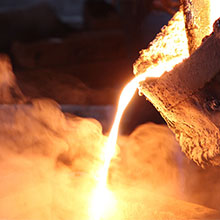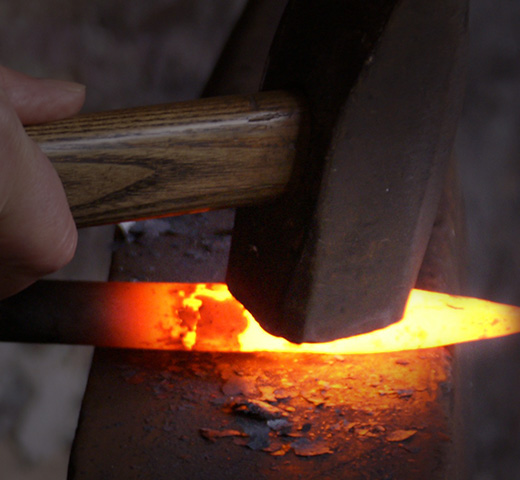You may, in the development of a new project or product, find that you need a metal part that doesn’t exist yet or needs to be created to custom specifications. A quick search reveals any number of metallurgical firms that can create said part for you, but their methods of doing so vary. Some create castings and other forgings, and the difference between Forging and Casting may not be immediately apparent if this is your first time in this situation.
You want a part that’s going to be reliable and durable, one that’s going to contribute to the excellence of your product or project. Forging vs casting? Which process is more suited to create the part you need at the quality you desire? Find out below!

What is Casting?
The core of casting is in heating the component metal to a molten state and pouring it into a prepared mold. Though the mold is most often a die, sand and investment casting are often used for specific alloys or for parts with unusual dimensions and design. Once the metal cools into the basic desired shape, the metalworker then finishes the part with the details requested by the client either by hand or through further machining.
What is Forging?
Though the heating of the component metal is also essential to forging, heating for this method never gets so intense as to make said metal melt. Instead, it’s merely made hot enough to make it possible for the metalworker to conduct hammer forging or otherwise manipulate it into a prepared die. Gigantic presses are used for larger products and the method of forging can vary depending on the desired final product; forging may be a hot or cold forging process, for example, or may make use of an open or closed die.
Forged Vs. Cast: Which is Better?
As with most comparisons, one method is preferred for certain projects while the other is better suited to others. To start with, let’s go over the benefits and drawbacks of each method.
Casting Benefits
- Melting of metal allows it to be formed into greater variety of shapes, which allows for greater flexibility in part design
- Initial results are often closer to design specifications, lessening time spent on secondary machining and processing
- Cast parts are nearly always lighter than their forging counterparts
- Modifications of part designs and associated molds are comparatively easy and quick to execute
Casting Drawbacks
- Cast parts are typically more porous than forged and can contain inadvertent voids
- Cast parts do not possess as much tensile or fatigue strength as forged
- Casting requires closer observation on the part of the metalworker to ensure overall quality and prevent the formation of defects
Benefits of Forging
- The method of altering the metal’s grain structure typically leads to superior structural integrity and mechanical strength
- The process, of forging, is typically less expensive than casting thanks to less intensive labor requirements and less involvement of material scrap
- Forging, by and large, eliminates surface porosity along with voids and other defects
- Forging is more consistent in the yield of produced parts and in producing parts that are incredibly strong and ductile
Forging Drawbacks
- Extensive post-forging machining or processing may be necessary to make a part meet exact design specifications
- The nature of the forging process limits the complexity of parts that can be created through forging
- Forging with custom alloys is extremely difficult due to the fact that the metal remains solid throughout the process
Even after reading all that about the difference between forging and casting, you may still not be certain as to which method is appropriate for your part. There are, after all, projects that can be executed through both casting and forging, and on paper, both methods seem capable of producing quality results. The difference between forging and casting, however, become much more stark when you look at those results
In a 2007 research paper, researchers at the University of Toledo compared the differences between one type of product made both ways. Though it was not surprising that the forging process exhibited greater quality in nearly every aspect, what was surprising was just how superior the forging process proved itself to be. Based on the results of this study, the following conclusions were drawn:
- The tensile strength of forged parts is 26% higher than that of cast parts.
- The fatigue strength of forged parts is 37% higher than that of cast parts.
- Cast iron exhibits only 66% of the yield strength of forged steel.
- Forged parts exhibit a 58% reduction in area when pulled to failure, while cast parts exhibit a 6% reduction in area.
That last bullet point may be the most striking of them all, as it shows the superiority of forging parts even in failure. The increased reduction in area, after all, means that a forged part must undergo a great amount of deformation before it’ll fail; some cast parts, meanwhile, merely need to be looked at the wrong way in order to fall apart. Generally speaking, however, all of these results indicate what experienced metalworkers have known for years. Simply put, forging will virtually always result in a part that is stronger and more reliable than a cast counterpart.
Canton Drop Forge – Experience and Reliability.
At Canton Drop Forge, we recognize that there are certain situations in which casting may be the superior option in part creation. Perhaps your design is incredibly intricate or must be made of a custom alloy. In the vast majority of situations, however, forging is the smart choice both in terms of affordability and in terms of creating the best part possible. We hope that this breakdown has given you the information you need to proceed with the creation of your part – if you have any further questions about the differences between forging and casting, please feel free to get in touch with one of our helpful and knowledgeable customer service representatives.
